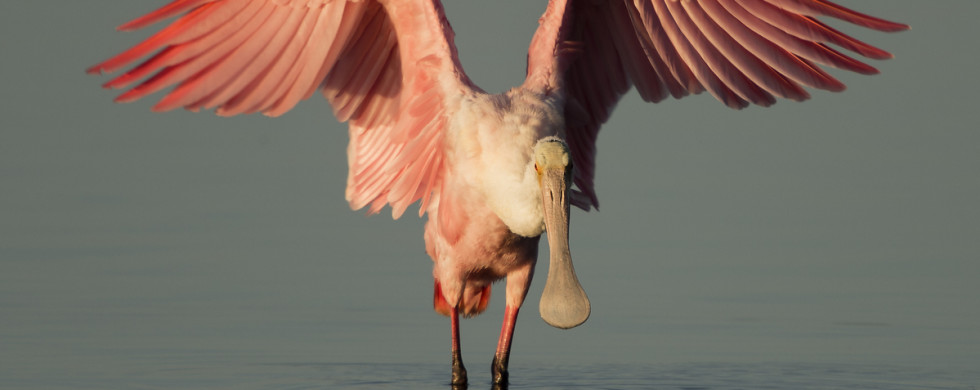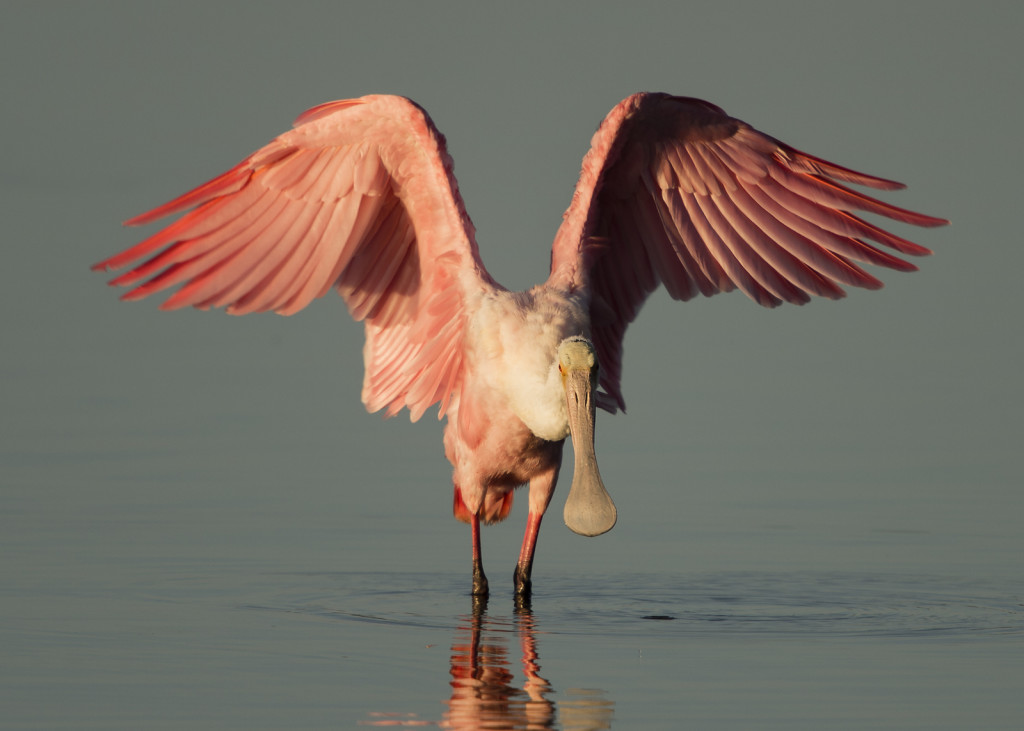
31
2015A Spoonful of Pink
Shot of the Month – January 2015
 This month an image of one of Florida’s marquee birds. Now if you are not paying close attention you might think this is a shot of Florida’s renowned pink flamingo. Wading bird – Check. Pink plumage – Check. Florida – Check. But the giveaway that this is not a flamingo is in the bill. Check out the big spatula on Brad (pop culture reference). What we got here is a Roseate Spoonbill — Florida’s other pink bird.
This month an image of one of Florida’s marquee birds. Now if you are not paying close attention you might think this is a shot of Florida’s renowned pink flamingo. Wading bird – Check. Pink plumage – Check. Florida – Check. But the giveaway that this is not a flamingo is in the bill. Check out the big spatula on Brad (pop culture reference). What we got here is a Roseate Spoonbill — Florida’s other pink bird.
Myth Buster Alert: I, like most Americans I imagine, associate flamingos with Florida. Turns out that the American Flamingo does not breed in Florida and the occasional sighting is most likely that of a bird that escaped from captivity. In lower Florida, in the southern reaches of the Everglades, you may see a flamingo that is a vagrant from the Yucatan Peninsula. When Europeans first discovered Florida there was a small breeding population but that population either died off or migrated to other locations further south. So, despite all the flamingos in the souvenir shops, flamingos are not really part of Florida’s natural landscape. Wow, mind officially blown. (source)
But we are here to talk about a true Floridian — the Roseate Spoonbill. There are six species of spoonbill around the world and the Roseate is the only one that is pink. And it is the only one found in the Western Hemisphere. Roseate Spoonbills are typically found in Central and South America as far south as Argentina and Chile. They can also be found in the Bahamas, the Caribbean, and Cuba. In the US the breeding range is limited to coastal Texas, southwestern Louisiana, and Southern Florida. A popular place to see the Roseate Spoonbill is in Ding Darling National Wildlife Refuge where I photographed this fellow.
The Roseate Spoonbill uses that signature bill to good use — it is a very effective tool for catching dinner. In the early morning and late afternoon the spoonbill can typically be seen wading through shallow water, head down, as it sweeps its bill from side to side near the bottom of the water with its mandibles slightly open. The bill has very sensitive nerves and will snap shut rapidly if prey is felt. Notice the two narrow slits near the top of the bill? They allow the bird to continue breathing even while the bill is submerged looking for prey. Pretty smart. Minnows comprise 85% of the spoonbill’s diet though they also eat shrimp, mollusks, frogs, newts, and some types of aquatic plants. Like flamingos, the spoonbill gets its pink color from the algae that is found in the crustaceans that the bird consumes.
Florida was almost left completely pink-free in the 1800s as the population was decimated by professional plume hunters to make hats and fans for stylish ladies of that era. By 1930 only 30-40 breeding pairs remained. Fortunately, action was taken and hunting of the bird was banned and special conservation areas were created to protect the bird. Since then the population has rebounded and about a thousand breeding pairs live in Florida. Today the main threat to the spoonbill is the loss of habitat as Florida continues to expand human settlements into coastal areas where spoonbills typically live.
Well, at least for the moment it is great news that the Roseate Spoonbill is literally, and figuratively, “in the pink.” (collective groan)
Until next month….m
Shot Information:
Nikon D4S, Nikon 600 mm w/ 1.4 x TC (effective 850 mm), f/5.6, 1/750s, ISO 200,

patricia mountjoy
will i see any in naples, fl? finally going to visit brother buzz end of march.